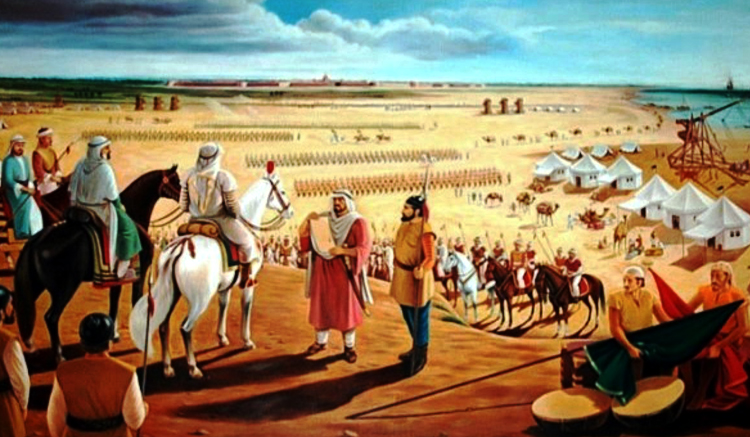Political History Arrival, Foundation and Consolidation of Muslim Rule in India
The end of Muslim rule in India was as spasmodic as its beginning. It took five hundred years for its establishment (712-1206) and one hundred and fifty years for its decline and fall (1707-1857). The benchmarks of its establishment are C.E. 712 when Muhammad bin Qasim invaded Sind, 1000 when Mahmud of Ghazni embarked upon a series of expeditions against Hindustan, 1192-1206 when Prithviraj Chauhan lost to Muhammad Ghauri and Qutbuddin Aibak set up the Turkey Sultanate at Delhi, and 1296 when Alauddin Khalji pushed into the Deccan. The stages of its downfall are 1707 when Aurangzeb died, 1739 when a trembling Mughal Emperor stood as a suppliant before the Persian Invader Nadir Shah, 1803 when Delhi was captured by the British, and 1858 when the last Mughal ruler was sent to Rangoon as a prisoner of the Raj.
For five centuries-thirteenth to seventeenth-however, most parts of India were under Muslim rule, though with varying degrees of effectiveness in different regions of the country. But at no single point of time was the whole country ruled exclusively by the Muslims. On the other hand, the five hundred year long Muslim rule did not fail to influence Indian political and cultural life in all its facets. Muslim rule apart, Muslim contact with India can be counted from the seventh century itself. Naturally, the interaction of Muslim culture with the Hindu way of life, backed by the superimposition of Muslim rule in India, gave rise to a sort of a common Indian culture. But only a sort of, there is a superficial veneer about it. On the face of it the influence of Islam on Indian culture is to be seen in all spheres of life, in architecture, painting, music, and literature; in social institutions like marriage ceremonies, in eating habits, in gourmet and cuisine, sartorial fashions and so on. In actual fact, Hindus and Muslims lead their own lives, mostly in isolation from one another, except for personal friendships. Even living together for a thousand years has not welded Hindus and Muslims into one people. Why is it so?
Because Islam believes in dividing humanity into believers and Kafirs, the Muslim community (Ummah) is enjoined not to cooperate on the basis of equality or peaceful coexistence with Kafirs. To them it offers some alternatives-conversion to Islam, or death, or slavery. At the most it allows survival on payment of a poll-tax, Jiziyah, and acceptance of a second-class status, that of Zimmi. As a matter of fact, Muhammadans invaded India to turn it into a land of Islam and spread their culture. Islamic culture is carrier culture, borrowed from exotic streams. The main contribution of Islamic culture is Quran and Hadis. It invaded Indian culture not to co-exist with it but to wipe it out. Its declared aim was Islamization through Jihad. But in spite of repeated endeavors through invasions and centuries of Muslim rule, India could not be turned into a Muslim country. Had India been completely converted to Islam, its people, like those of Iran or Libya, would have taken pride in organizing Islamic revolutions, spearheading Pan-Islamic movements and espousing right-or-wrong Islamic causes. Or, had Hindus the determination and the wherewithal to throw out Islam from India as was done by the Christians in some countries like Spain, there would have been no Muslim problem in India today. But here Muslims stay put, and yet a thousand years of Muslim contact failed to Islamize India. India, therefore, provides a good study to evaluate the achievements and failures, atrocities and beneficences, fundamentalism and secularism of Muslim rule and Muslim people. In the appraisement of Muslim rule, Muslim religion also cannot escape scrutiny, for the former was guided by the latter, the one being inseparable from the other. This makes the assessment of the legacy of Muslim rule in India an extremely controversial subject. Its contribution comprises of both bitterness and distrust on the one hand and on the other a composite common culture. We shall take up the common culture first. Muslim Rule in India
Check also: 10 Surprising Facts About the Human Brain You Didn’t Know
So much has already been written about the development of Indo-Muslim composite culture, its give and take and its heritage, that it is neither necessary nor possible to touch upon all its aspects. Therefore, only a few areas may be taken up-like music and architecture-in which Muslims have made special and substantial contribution. In other branches of fine arts like painting, the story too is familiar. Many Mughal paintings bear the touch of Ajanta or its regional variations, while Rajputs and Pahari Qalam adopted a lot from Muslim miniature style and art of portraiture. Equally important is the Muslim contribution in the sphere of jewellery, textiles, pottery etc. In the fields of sport and athletics, again, Muslim participation has been both extensive and praiseworthy. Muslim Rule in India
The first and only Arab invasion coincided in date with two other signal successes in distant parts of the globe. Gothic Spain was shattered at the battle of the Guadalete in 710; the standards of Islam were carried from Samarkand to Kashghar in 711-714; and the valley of the Indus was invaded in 712. Muslim Rule in India These three steps mark the apogee of the power of the Omayyad caliphate, and coincide with the administration of one of the ablest and most relentless of all Muslim statesmen. Al-Hajjaj, the governor of Chaldea, sent Kutaiba north to spread Islam over the borders of Tartary, and at the same time dispatched his own cousin Mohammad Qasim to India. The reigning caliph consented unwillingly; he dreaded the distance, the cost and the loss of life. Even in those days, to adapt modern phrases, there were the opposing policies of ‘Little Arabians ‘ and ‘Imperialists.’ Hajjaj was imperialist to the core and to him the Arabs owed the impulse which gave them all they ever won in India. The story of Mohammad Qasim’s adventures is one of the romances of history. He was but seventeen, and he was venturing into a land scarcely touched as yet by Saracen spears, a land inhabited by warlike races, possessed of an ancient and deeply rooted civilization, there to found a government which, however successful, would be the loneliest in the whole vast Mohammedan empire, a province cut off by sea, by mountains, by desert, from all peoples of kindred race and faith. Youth and high spirit, however, forbade alike fear and foreboding. The young general had at least six thousand picked horsemen to his back, chosen from the caliph’s veterans, with an equal number of camelry, and was supplied with a baggage train of three thousand Bactrian camels. Marching through Makran, along the Persian coast, he was joined by the provincial governor with more troops; and five stone-slings for siege-work were sent by sea to meet him at Daibul, the great mediaeval port of the Indus valley, the forerunner of Karachi. Muslim Rule in India There in the spring of 712 Mohammad Qasim set up his catapults and dug his trench. A description of this siege has come down to us from an early historian from which it appears that the Arab spearmen were drawn up along the trench, each separate company under its own banner, and that five hundred men were stationed to work the heavy catapult named ‘ the Bride.’ A great red flag flaunted on the top of a tall temple, and the order came from Hijaj, with whom the general was in constant communication, to ‘fix the stone sling and shorten its foot and aim at the flagstaff.’ So the gunners lowered the trajectory and brought down the pole with a shrewd shot. The fall of the sacred flag dismayed the garrison; a sortie was repulsed with loss; the Muslims brought ladders and scaled the walls, and the place was carried by assault. The governor fled, the Brahmans were butchered, and after three days of carnage a Mohammedan quarter was laid out, a mosque built, and a garrison of four thousand men detached to hold the city. Muslim Rule in India
After the storming of Daibul, the young general marched up the right bank of the Indus in search of the main body of the enemy. Discovering their outposts on the other side, he tied a string of boats together, filled them with archers, made one end fast to the west bank, and then let the whole floating bridge drift down and across, like an angler’s cast of flies, till it touched the opposite side, where it was made fast to stakes under cover of the archers’ arrows. The enemy, unable to oppose the landing, fell back upon Rawar, where the Arabs beheld for the first time the imposing array of Hindu chiefs, mounted on armored war-elephants, and led by their king Dahir. Naphtha arrows, however, disordered the elephants and set fire to the howdahs; the king was slain, the Hindus fled, and ‘the Muslims were glutted with slaughter.’ Muslim Rule in India
The Indian women showed the desperate courage for which they were famous. The king’s sister called them together, on seeing the defeat of their men; and, refusing to owe their lives to the ‘vile cow-eaters,’ at the price of dishonor, they set their house ablaze and perished in the flames. Another victory at Brahmanabad opened the way to Multan, the chief city of the upper Indus, which surrendered at discretion, but not without an exhausting siege. The fighting men were massacred; the priests, workmen, women, and children made captives. The fall of Multan laid the Indus valley at the feet of the conqueror. The tribes came in, ‘ringing bells and beating drums and dancing,’ in token of welcome. The Hindu rulers had oppressed them heavily, and the Jats and Meds and other tribes were on the side of the invaders. The work of conquest, as often happened in India, was thus aided by the disunion of the inhabitants, and jealousies of race and creed conspired to help the Muslims. To such suppliants, Mohammad Qasim gave the liberal terms that the Arabs usually offered to all but inveterate foes. He imposed the customary poll-tax, took hostages for good conduct, and spared the people’s lands and lives.
He even left their shrines undecorated: ‘the temples,’ he proclaimed,’ shall be inviolate, like the churches of the Christians, the synagogues of the Jews, and the altars of the Magians.’ There was worldly wisdom in this toleration, for the pilgrims’ dues paid to the temples formed an important source of revenue, and the puritanical Muslims found it expedient to compound with idolatry, as a vain thing but lucrative, in the interests of the public fisc. Occasional desecration of Hindu fanes took place, —we read of ‘a cart-load of four-armed idols’ sent as a suitable gift to the caliph, who no doubt preferred specie — but such demonstrations were probably rare sops to the official conscience, and as a rule the Mohammedan government of Multan was at once tolerant and economic. The citizens and villagers were allowed to furnish the tax-collectors themselves; the Brahmans were protected and entrusted with high offices, for which their education made them indispensable; and the conqueror’s instructions to all his officers were wise and conciliatory ‘ Deal honestly,’ he commanded, ‘between the people and the governor; if there be distribution, distribute equitably, and fix the revenue according to the ability to pay. Be in concord among yourselves, and wrangle not, that the country be not vexed.’ The young general’s fate was tragic. A new caliph succeeded who was no friend to the conqueror of Sind. Hijaj was dead, and there was none to oppose factious intrigues at the distant court of Damascus. In spite of his brilliant achievement, Mohammad Qasim was disgraced and put to death. The story runs that he had made too free with the captive daughters of Dahir before presenting them to the caliph’s harem, and that he was punished for the presumption by being sewn up alive in a raw cow-hide.’ Three days afterwards the bird of life arose from his body and soared to heaven’; and the hide with its noble burden was sent to Damascus. The young hero had made no protest, never questioned the death-warrant, but submitted to the executioners with the fearless dignity he had shown throughout his short but valiant life. But when the sacrifice was accomplished, the Indian princesses, moved perhaps by the courage of a victim brave as their own devoted race, confessed that their tale was deliberately invented to avenge their father’s death upon his conqueror. Muslim Rule in India
The caliph in impotent fury had them dragged at horses’ tails through the city till they miserably perished, but the second crime was no expiation for the first. The Arabs had conquered Sind, but the conquest was only an episode in the history of India and of Islam, a triumph without results. Muslim Rule in India The Indus province, it is true, is as large as England, but it consists chiefly of desert, and the Arabs made no attempt to extend their dominion into the fertile plains beyond. It has been supposed that the crude civilization and austere creed of the Muslims stood paralyzed in face of the rich and ancient culture, the profound philosophy, and the sensual ritual of the Hindus; but these contrasts did not check the later successes of Islam in the same land. The more obvious explanation of the Arabs’ failure is found in the as yet unbroken strength of the Rajputs kings on the north and east, and in the inadequate forces dispatched by the caliphs for so formidable a project as the conquest of India. After the first expedition under the ill-fated Mohammad Qasim we hear of no reinforcements, and twenty years after his death the Arabs were still so insecure on the Indus that they built a city of refuge as a retreat in times of jeopardy. Muslim Rule in India
The province was not only imperfectly subdued but extremely poor, and the caliphs soon abandoned it in all but name as too unremunerative to be worth maintaining. The Arab settlers formed independent dynasties at Multan and at the new city of Mansura which the conqueror’s son founded in lower Sind; and when the traveler Mas’udi visited the valley of the Indus in the tenth century he found chiefs of the Prophet’s tribe of the Kuraish ruling both the upper and the lower province. A little later another traveler, Ibn- Haukal, explored Sind, where he heard Arabic and Sindhi spoken, and observed much friendly toleration between the Muslim and Hindu population. Soon afterwards Multan became a refuge for scattered bands of Karmathian, when the power of these anarchists waned before the rising ascendancy of the Fatimid caliphs of Egypt, and Arabia was delivered from the Karmathian reign of terror. But the meager annals of this limited and ineffectual occupation of an unimportant province need not detain us. The Arab conquest of Sind led to nothing, and left scarcely a vestige saves in the names of certain Arab families and in the ruins of the buildings they destroyed. The Arab cities have perished, but the wrecks of the castles and cities of their predecessors, which formed as usual the quarries for their conquerors’ buildings, still bear witness to the civilization which they uprooted. Muslim Rule in India









Respected Sir, please add option to download